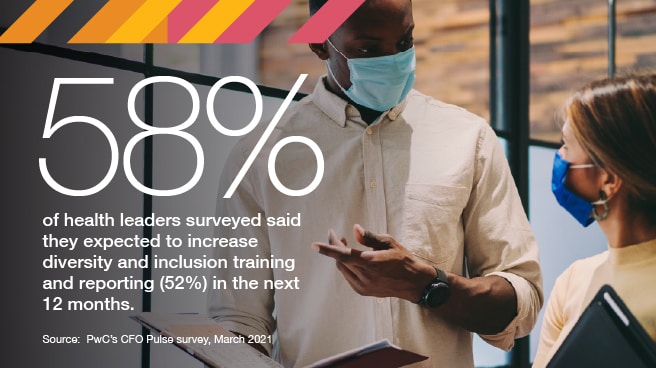{{item.title}}
{{item.text}}

{{item.text}}
Providers, payers and pharmaceutical and life sciences organizations have historically embraced the social pillar of environmental, social and governance (ESG) efforts, caring for patients and creating medications, vaccines and devices that improve human health and save lives. PwC’s Health Research Institute (HRI) analyzed the ESG efforts of 45 health systems and payers and 32 pharmaceutical and life sciences companies, finding health organizations could reap additional rewards by also embedding more of an environmental and governance focus into their overall strategy.
Download for more information:
ESG for providers and payers
ESG for pharma and life sciences
For-profit and not-for-profit healthcare organizations have different motivators, audiences and reporting requirements when it comes to ESG, but both serve communities that are increasingly aware of what socially responsible organizations look like. Additionally, government bodies, regulators, investors and consumers have increased expectations for responsible business practices. Providers and payers have ample opportunities to differentiate themselves by improving their reporting and storytelling around ESG, and to build trust with the communities they serve, and with investors, donors and other stakeholders.
Embed ESG in your strategy and purpose. Many healthcare organizations have the opportunity to move beyond press releases to build meaningful ESG efforts throughout their business — from their supply chains to environmental footprints, from recruiting efforts to executive leadership composition. As any ESG strategy should, these steps mostly already align with organizations’ overall mission to improve community health. Broader public awareness about sustainability and corporate responsibility means organizations can differentiate themselves by acting early to build ESG strategies that can enhance reputations with customers, employees, investors and analysts. ESG is a critical driver to capture opportunity and keep ahead of vulnerability.
Measure for transparency and accountability. Some healthcare organizations may be able to take giant leaps in their ESG reporting by better measuring and quantifying what they are already doing in these arenas, to be sure they are sharing the value they are already creating for society. It may require new processes to capture data, or working with third parties, but healthcare leaders can use proven tactics and smarter technologies to identify, measure and hold their business accountable to ESG principles. Some have already started expanding data collection efforts to better report on societal racial inequities in outcomes and the steps they are taking to address them. Healthcare organizations can take a proactive approach to telling their story — to employees, customers, shareholders, suppliers and other stakeholders — using these trusted metrics and disclosures.
Create a practical plan for action. Creating value and impact through ESG means viewing it as more than an obligatory requirement and developing a tangible and practical plan that you can act on. It requires people and technology working together so organizations can see more, go deeper and act faster to make ESG-driven changes to their operations, value chain and organization. Providers and payers can consider how to operate the business more efficiently throughout, from electricity use to travel, and take first steps in new areas, to more effectively advance their ESG goals in each pillar.
This may be the ideal time for pharmaceutical and life sciences organizations to embrace a broader ESG strategy. Government bodies, regulators, investors and consumers have increased expectations for responsible business practices. ESG principles should be embedded throughout a business through an actionable plan, as a company’s ESG performance can be a good indicator of future success. Thorough ESG plans also can create a cost advantage when sustainability measures are embedded into product development, such as through green chemistry.
Embed ESG in your strategy and purpose. Many pharmaceutical and life science companies have the opportunity to move beyond platitudes to build action-oriented ESG efforts throughout their business — from supply chains to environmental footprint, clinical trial diversity to executive leadership composition. Like any ESG strategy should, these steps should already align with the organizations’ overall mission. Broader public awareness about sustainability and corporate responsibility means organizations can differentiate themselves by acting early to build ESG strategies that enhance reputations with customers, employees, investors and analysts. ESG is a critical driver to capture opportunity and keep ahead of vulnerability.
Measure for transparency and accountability. Some pharmaceutical and life sciences companies may be able to take giant leaps in their ESG reporting by better measuring, quantifying and communicating what they already are doing in these arenas, to be sure they are sharing the value they already create for society. It may require new processes to capture data, or working with third parties, but leaders can use proven tactics and smarter technologies to identify, measure and hold their business accountable to ESG principles. Companies can take a proactive approach to telling their story — to employees, customers, shareholders, suppliers and other stakeholders — using these trusted metrics and disclosures.
Create a practical plan for action. Creating value and impact through ESG means viewing it as more than a charity effort, and developing a tangible and practical plan you can act on. It requires people and technology working together so companies can see more, go deeper and act faster to make ESG-driven changes to their operations, value chain and organization. Pharmaceutical and life science companies can consider how to operate the business more efficiently throughout, from electricity use to travel, and take first steps in new areas, or more fully advance their ESG goals in each pillar.
{{item.text}}

{{item.text}}



